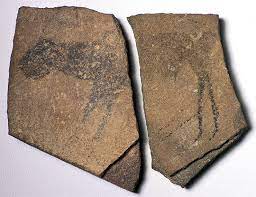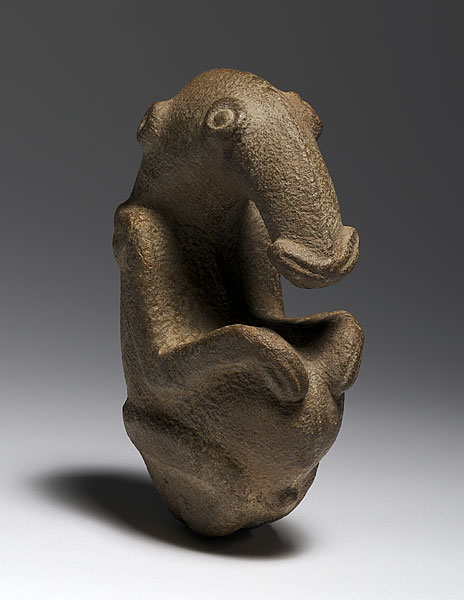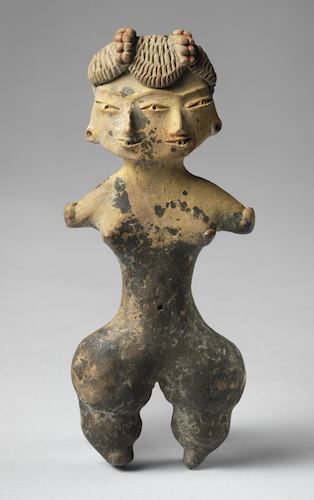1.1 Cultural Influences on Prehistoric Art
4 min read•june 18, 2024
Sylvia Rodriguez
AP Art History 🖼
34 resourcesSee Units
The study of prehistoric art offers a unique glimpse into the ancient cultures and societies that existed before the invention of writing. These early artworks, often made from materials such as stone, bone, and clay, provide valuable insights into the religious beliefs, social structures, and technological advancements of the time. This guide will focus on three specific prehistoric artworks: the Apollo 11 Stones, the Ambum stone, and the Tlatilco female figure, and will explore the cultural influences that shaped them.
Apollo 11 Stones:

Apollo 11 Cave Stones, Namibia, quartzite, c. 25,500–25,300 B.C.E. Image courtesy of State Museum of Namibia.
- The Apollo 11 Stones are a group of prehistoric artifacts found in the desert of Namibia, Africa. They date back to around 25,000 BCE and are believed to be among the earliest examples of human-made art.
- The stones are decorated with intricate geometric patterns, including circles, lines, and dots, that are thought to represent the natural world and spiritual beliefs.
- The style of the Apollo 11 Stones is typical of the San people, an indigenous group that lived in southern Africa during this time period.
- The San people were hunter-gatherers who lived in small, mobile groups, which likely influenced the abstract and symbolic nature of the Apollo 11 Stones.
The Ambum stone:

Ambum Stone, c. 1500 B.C.E., greywacke, 20 x 7.5 x 14 cm, Ambum Valley, Enga Province, Papua New Guinea (Australia National Gallery, Canberra)
- The Ambum stone is a prehistoric sculpture found in the highlands of Papua New Guinea. It dates back to around 1500 BCE and is made of a type of volcanic rock called pumice.
- The sculpture depicts a human figure with exaggerated features, including large eyes, a broad nose, and a wide mouth.
- The Ambum stone is believed to have been used in rituals and ceremonies, and its exaggerated features may reflect the importance of certain physical characteristics in the culture that created it.
- The style of the Ambum stone is typical of the people of the New Guinea highlands, who were known for their highly developed ceremonial and ritual practices.
Tlatilco female figure:

Double-faced female figurine, early formative period, Tlatilco, c. 1200–900 B.C.E., ceramic with traces of pigment, 9.5 cm. high (Princeton University Art Museum)
- The Tlatilco female figure is a ceramic sculpture found in the Tlatilco neighborhood of Mexico City. It dates back to around 1200 BCE and is one of the earliest examples of ceramic art in the Americas.
- The sculpture depicts a female figure with large hips and breasts, which may indicate the importance of fertility and motherhood in the culture that created it.
- The Tlatilco female figure is an example of the Olmec culture, which is known for its advanced ceramics and metallurgy.
Cultural Influences:
- Prehistoric art is shaped by the cultural beliefs and practices of the societies that created it.
- The Apollo 11 Stones, The Ambum stone, and the Tlatilco female figure all reflect the specific cultural influences of the people who made them.
- The San people of southern Africa were hunter-gatherers who lived in small, mobile groups, which likely influenced the abstract and symbolic nature of the Apollo 11 Stones.
- The people of the New Guinea highlands were known for their highly developed ceremonial and ritual practices, which is reflected in the Ambum stone.
- The Olmec culture, which created the Tlatilco female figure, was known for its advanced ceramics and metallurgy.
To summarize:
The Ambum stone is a prehistoric sculpture that was discovered in the Ambum Valley of Papua New Guinea. It is believed to date back to around 1500 BCE and is thought to have been created by the Kukukuku people, a tribe that inhabited the area at the time. The sculpture is significant because it is one of the oldest examples of figurative art from the region and it is believed to have been used in ritual or ceremonial contexts.
The Apollo 11 Stones were discovered in Namibia in Africa, date back to around 25,000 BCE and are considered one of the earliest human-made art forms. Adorned with intricate geometric patterns & allusive to the San people's style, these artifacts offer insights into the spiritual and natural world beliefs of the time which reflected the hunter-gatherer lifestyle of the indigenous groups in Southern Africa.
The Tlatilco female figure is a pre-Columbian sculpture that was discovered in Tlatilco, Mexico. It is believed to date back to around 1200 BCE and is thought to have been created by the Tlatilco culture, a civilization that flourished in the region during the Formative period. The sculpture is significant because it is an early example of figurative art from the region and it is thought to have been used in ritual or ceremonial contexts.
In general, all of these artworks are significant because they provide insights into the cultural and religious beliefs of the people who created them. They are also important because they help to paint a picture of the prehistoric era, showing how people lived, what they believed in and how they expressed themselves through art.
Browse Study Guides By Unit
🗿Unit 1 – Global Prehistoric Art, 30,000-500 BCE
🏛Unit 2 – Ancient Mediterranean Art, 3500-300 BCE
⛪️Unit 3 – Early European and Colonial American Art, 200-1750 CE
⚔️Unit 4 – Later European and American Art, 1750-1980 CE
🌽Unit 5 – Indigenous American Art, 1000 BCE-1980 CE
⚱️Unit 6 – African Art, 1100-1980 CE
🕌Unit 7 – West and Central Asian Art, 500 BCE-1980 CE
🛕Unit 8 – South, East, and Southeast Asian Art, 300 BCE-1980 CE
🐚Unit 9: The Pacific, 700–1980 ce
🏢Unit 10 – Global Contemporary Art, 1980 CE to Present
📚Study Tools

Fiveable
Resources
© 2025 Fiveable Inc. All rights reserved.